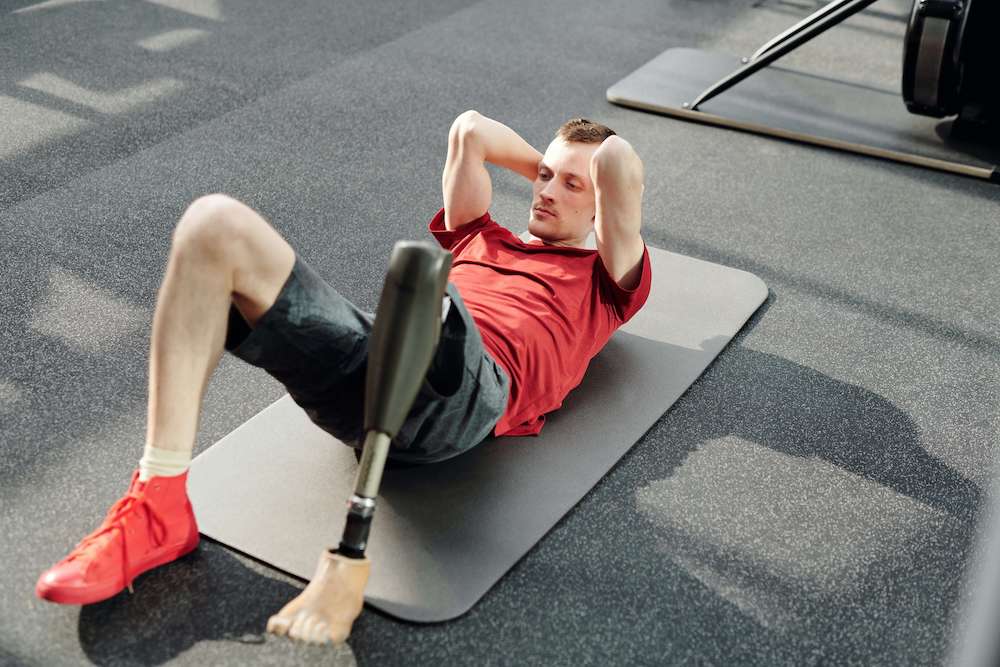There exists an argument among strength coaches, physical therapists, and personal trainers regarding whether the spine should be flexed to work the abdominals, as with crunches, sit-ups, and hanging-leg raises. Concerns arise regarding the spine’s finite number of flexion cycles, with some fearing that excessive flexion movements could lead to spinal degeneration. Some fitness experts have confidently argued that “flexion is the enemy of the spine.”
Our spines are in flexion for the majority of the day while working at desks, eating, and driving. Lower back disc bulges that protrude toward the back (caused by spinal flexion) are far more frequent than those protruding forward (caused by spinal extension).
The Research
Based on research showing a cause-effect relationship between spinal flexion of pig spines and disc damage, some coaches believe that additional spinal flexion within the strength and conditioning world should be avoided at all costs.
Bret Contreras and Brad Schoenfeld (2011) wrote an article called “To Crunch or Not to Crunch: An Evidence-Based Examination of Spinal Flexion Exercises, Their Potential Risks, and their Applicability to Program Design”. The following points stood out for me;
- In vitro (not studied in the body), research has implicated that repeated lumbar flexion is the primary mechanism of disc problems (herniations and prolapses). However, in vitro studies, the muscles, supporting structures and natural responses to spinal flexion movement (including fluid flow, hormones, reflexes etc) have been taken out of the equation, therefore studying in vitro does not accurately show what would actually happen in the body (in vivo).
- Studies included thousands of reps without any rest between, which doesn’t accurately represent what would occur in an exercise program, such as 3 sets of 10 crunches.
- Degenerative disc disease is a multi-factorial process involving genetic, mechanical, biological and environmental factors and therefore it is inaccurate to point the finger at purely mechanical causes.
- Studies do not necessarily replicate what happens during an abdominal crunch, which involves flexing the trunk to 30 degrees, making the thoracic spine the region of greatest motion, not the lumbar spine and therefore reigning the entire argument negligible.
- Abdominal flexion was found to enhance spinal unloading, presumably through a greater movement of fluid in and out of the discs.
- Spinal motion has been shown to facilitate nutrient delivery to intevertebral discs.
- And finally, Spinal movements have repeatedly been shown to offer therapeutic benefits provided the exercise does not exceed the adaptive capacity of the tissue.

A picture of a crunch where the spine is flexed around 30 degrees with most movement occurring at the thoracic spine, not the lumbar spine.
If We Evolved From Apes…
Putting an evolutionary spin on things and considering our ape ancestors, would it be far-fetched to suggest that our spines might have a greater tolerance for hyperflexion rather than hyperextension? Observing most animals, they are quadrupeds, often maintaining a flexed-back position (similar to a constant crunch). Even those with bipedal capabilities, such as monkeys, meerkats, and bears, predominantly engage in quadrupedal activities, reserving bipedal stances for intermittent use. Have you ever heard of a meerkat slipping a disc due to excessive spinal flexion?
Nutrition Plays A Role
An area not addressed in the review relates to nutrition and the quality of joint integrity these pig spines actually had to begin with. Buy a raw conventional chicken and place it on the table next to a naturally raised chicken (organic/hormone-chemical free/free-range or as decent in quality that you can find) and then attempt to pull the legs off both chickens. You may notice the legs of the conventional 30-day-life-span-steroidal-chicken pop out of the socket like a hypermobile shoulder. The better quality chicken will be tricky as hell to pull apart. Now relate this to the quality of nutrition most folks developing lower back problems (the majority of people), have adopted. A life on Coca Cola and French fries doesn’t quite build up the body the way nature intended. With the pig spines used for the previously mentioned studies, I could bet my money on it that they didn’t use a wild or naturally raised pig, so it is questionable whether the joint structures had some decent integrity to begin with. Fancy eating some pork that has been fed newspaper, cardboard, cement dust and sewer sludge to fatten it up (Rampton S and Stauber J, 1997)?
Regardless of their Impact on the Spine, Are Crunches Really Necessary Anyway?
The core is effectively engaged during squatting, deadlifting, pulling, and other free-weight exercises, making it unnecessary to perform excessive amounts of targeted abdominal exercises to stimulate abdominal activation and strengthening. In sports where spinal flexion motions are prominent, such as brazilian jiu jitsu, wrestling, kickboxing, cycling and rowing, these athletes may be better off limiting extra time spend with the back flexed and work the core through anti-rotation and anti-extension movements. Such types of exercises could include;
- Abdominal roll-outs (wheel, swiss ball, slide board).
- Planks, weighted planks and RKC planks.
- Pallof presses and their variations.
- Half-kneeling/standing cable anti-rotation presses.
- Spinning a tornado ball above the head.
- Moving/catching/throwing/shaking a water ball.
- Torsionator / rotational trainer anti-rotation movements.
- Calisthenic bodyweight balances which strongly challenge the core.
All of these exercises require trunk stabilisation without flexing the spine.
Final Note
For someone who isn’t training in a sport where there is a great amount of amount of spinal flexion, and based on the current research, it is premature to conclude that spinal flexion exercises are inherently dangerous. Saying this however, there are certainly boundaries, as with anything, as to when excessive flexion and with high loads does become very problematic. As brought up previously, variety in spinal loading is associated with a lower risk of spinal diseases and can promote a healthier spine through enhanced nutrient delivery and spinal fluid movement. Everyone will handle exercises differently, some can tolerate more flexion in their spines than others. The best thing you can do is listen to your body and if you start developing a twinge in your lower back when you train spinal flexion exercises, don’t do them! Remember to also eat well, sleep well and rest well.
Check out my online coaching site for a plethora of direct and indirect core strengthening techniques.
